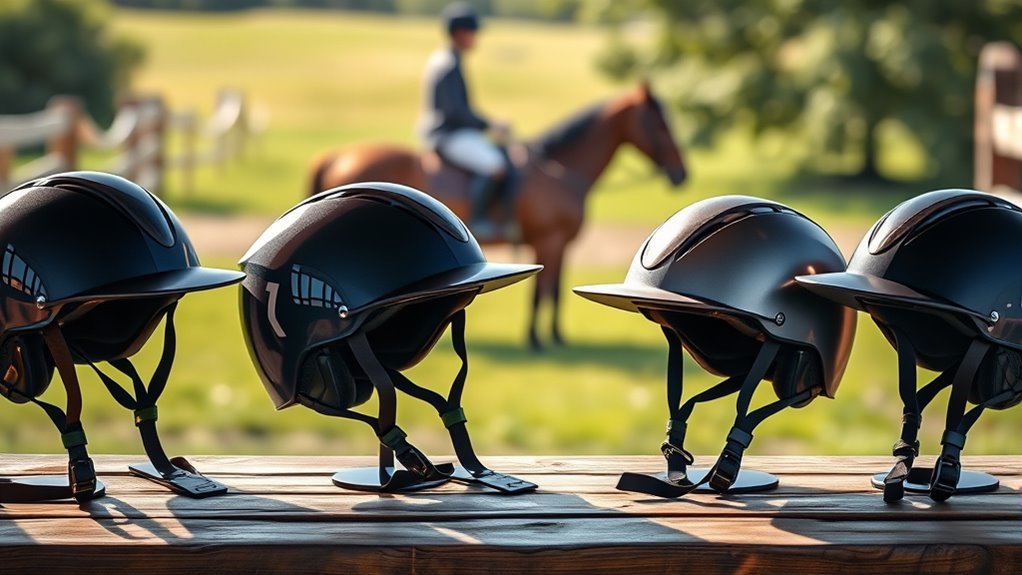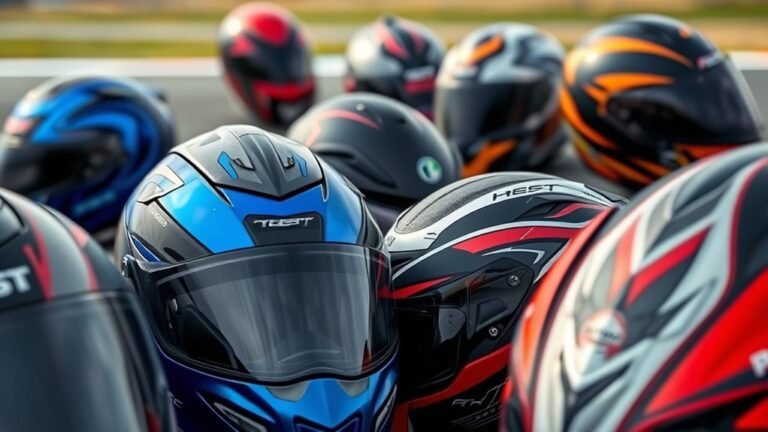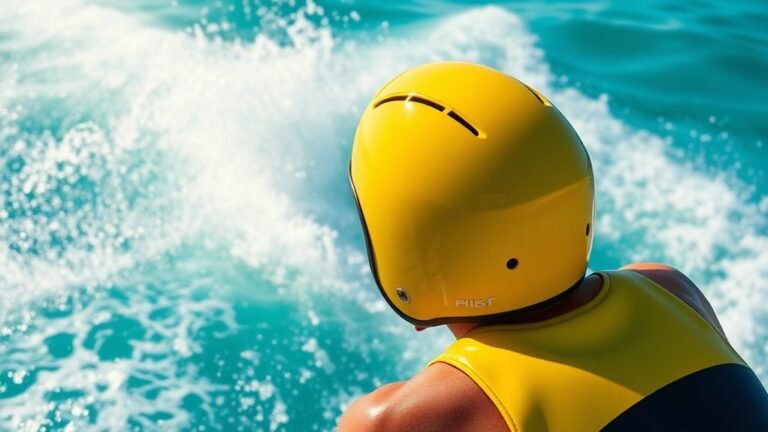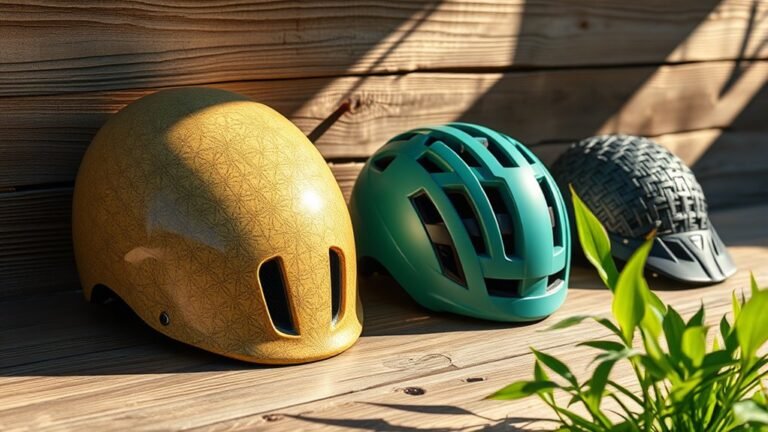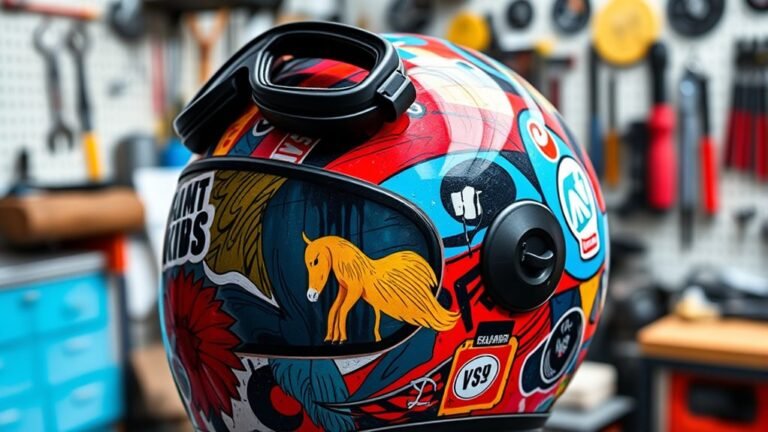Best Equestrian Helmets for Safety and Style
When selecting the best equestrian helmets for safety and style, prioritize those that meet ASTM and SEI safety standards. Look for durable materials, effective ventilation, and a lightweight design for comfort. Top brands like GPA and Troxel combine innovation with stylish aesthetics, offering options that reflect your personality. Whether you ride dressage or show jumping, there are helmets tailored to your discipline. If you want to explore more options and features, you might find valuable insights ahead.
Understanding Equestrian Helmet Safety Standards
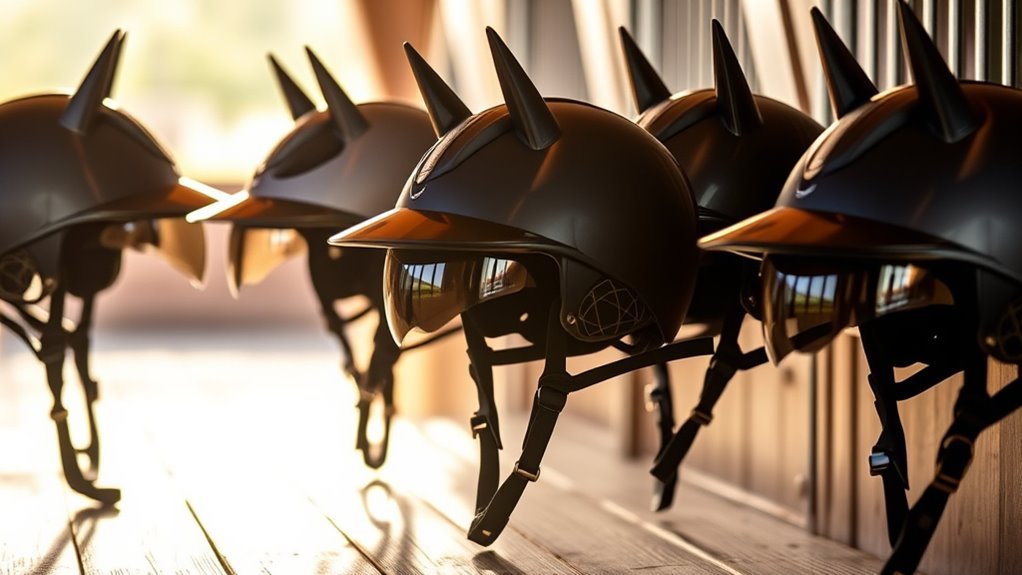
When you’re riding, understanding equestrian helmet safety standards is essential for your protection. Knowing the helmet certification processes can help you choose a reliable option. Various organizations, such as ASTM and SEI, oversee these processes to guarantee helmets meet strict safety requirements. During safety testing methods, helmets undergo rigorous examinations, including impact resistance and penetration tests, to simulate real-world conditions. These evaluations determine how well a helmet can protect your head in case of an accident. By familiarizing yourself with these standards, you empower yourself to make informed choices. A quality helmet not only enhances your riding experience but also supports your freedom to ride confidently, knowing you’re prioritizing your safety on horseback.
Key Features to Look for in a Helmet
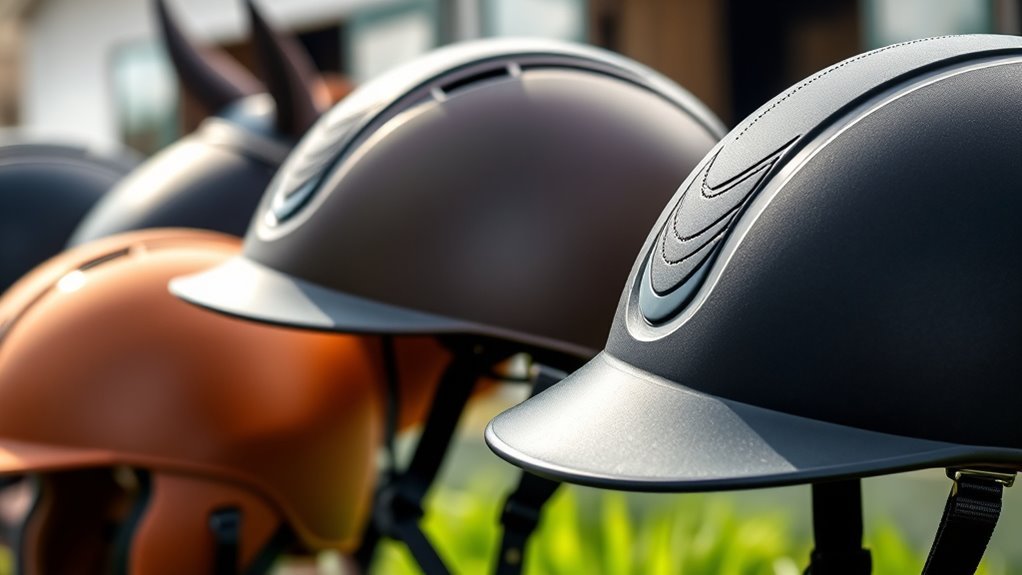
Choosing the right equestrian helmet involves more than just meeting safety standards; it’s about understanding the specific features that enhance both protection and comfort. First, consider material durability; helmets constructed from high-impact polycarbonate or fiberglass not only withstand falls but also provide longevity. Next, evaluate ventilation systems; an effective helmet should have ample airflow to keep you cool during long rides. Look for adjustable vents that can be customized based on weather conditions. Additionally, consider the weight of the helmet; a lighter design guarantees less neck strain without compromising safety. Finally, ascertain a proper fit with adjustable chin straps and padding, as comfort is essential for focus and performance. Prioritize these features for an enjoyable riding experience.
Top Brands for Equestrian Helmets
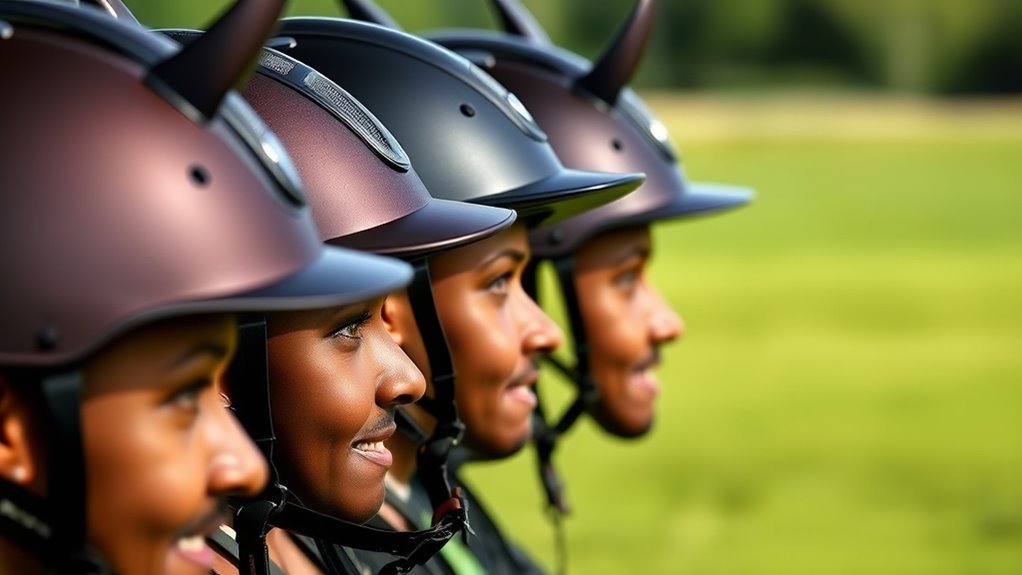
The landscape of equestrian helmets is dominated by several top brands known for their commitment to safety, comfort, and innovation. When you’re considering helmet options, brand comparisons reveal distinct strengths. For instance, brands like GPA and Kask are renowned for their cutting-edge helmet innovations, incorporating advanced materials that enhance impact resistance while maintaining a lightweight profile. Meanwhile, Troxel focuses on comfort and versatility, offering a range of sizes and styles suitable for various riders. If you’re looking for a balance between style and technical performance, brands like Samshield excel in combining aesthetics with safety features. Ultimately, the right helmet brand can greatly affect your riding experience, ensuring you ride freely while prioritizing your safety.
Stylish Designs for the Fashion-Forward Rider
Fashion in equestrian sports has evolved considerably, with riders increasingly seeking helmets that not only prioritize safety but also reflect their personal style. Today’s helmets boast fashionable patterns and vibrant colors, making it easier for you to find a design that resonates with your individuality. Brands are embracing unique textures and innovative motifs, allowing you to express your personality while ensuring maximum protection. Whether you prefer a sleek matte finish or an eye-catching glossy look, there’s a helmet to match your aesthetic. This fusion of safety and style empowers you to ride with confidence, knowing you’re making a statement. So why settle for the mundane? Choose a helmet that complements your passion and elevates your equestrian experience.
Lightweight vs. Heavy-Duty Helmets
While both lightweight and heavy-duty helmets serve the essential function of protecting your head, they cater to different riding styles and preferences. Lightweight materials make these helmets ideal for disciplines like dressage or casual riding, where comfort and breathability are paramount. They allow for greater freedom of movement and reduced fatigue during long rides. On the other hand, heavy-duty protection is vital for more intense activities such as jumping or trail riding, where the risk of falls and impacts is higher. These helmets often incorporate advanced materials and design features that prioritize safety over weight. Ultimately, your choice depends on your riding style, comfort preferences, and the level of protection you require for your equestrian adventures.
How to Properly Fit Your Equestrian Helmet
Properly fitting your equestrian helmet is essential for safety and comfort. Start by measuring your head circumference to determine the correct size, then adjust the helmet straps for a snug fit. Finally, check the stability of the helmet to guarantee it stays securely in place during rides.
Measuring Head Circumference
How can you guarantee your equestrian helmet fits correctly? Start by measuring your head circumference, which is essential for safety and comfort. Here’s how you can do it effectively:
- Gather your tools: Use a soft measuring tape or a piece of string and a ruler.
- Position the tape: Wrap it around the widest part of your head, typically just above your ears.
- Record the measurement: Ascertain the tape is snug but not tight; this accounts for your head shape.
- Double-check: Measure twice to confirm accuracy, as even slight variations can affect fit.
Using these measurement techniques will help you select a helmet that not only protects but also feels like a second skin.
Adjusting Helmet Straps
To guarantee your equestrian helmet fits snugly and securely, it’s crucial to adjust the helmet straps correctly. Start by identifying the strap materials; some may stretch over time, affecting fit. Utilize these adjustment techniques for ideal comfort and safety:
| Adjustment Technique | Description |
|---|---|
| Side Straps | Adjust for snugness around your ears. Confirm they sit just above the jawline. |
| Chin Strap | Tighten until it feels secure but comfortable, allowing for a two-finger gap. |
| Rear Adjustment | Use the dial or slider for a custom fit at the back of your head. |
| Overall Fit | Verify the helmet doesn’t wobble when you shake your head. |
With proper strap adjustments, you’ll achieve the freedom to ride confidently.
Checking Helmet Stability
Are you certain your helmet is stable enough to protect you during rides? Checking helmet stability is essential for your safety. Here’s how to verify your helmet fits snugly without excessive movement:
- Position: Place the helmet level on your head, confirming it sits just above your eyebrows.
- Strap Adjustment: Fasten the chin strap so it’s snug, but not uncomfortable. You shouldn’t be able to pull the helmet off easily.
- Stability Tests: Gently shake your head side to side; the helmet shouldn’t shift greatly.
- Check Fit: With a firm grip, try to rotate the helmet. It should move minimally, indicating ideal stability.
A well-fitted helmet minimizes helmet movement, offering the protection you need to ride freely and confidently.
Maintenance Tips for Longevity
While maintaining your equestrian helmet might seem like a minor task, proper care is essential for safeguarding its longevity and effectiveness. Start with effective cleaning methods; use a damp cloth and mild soap to wipe away sweat and grime after each ride. Avoid harsh chemicals that could degrade the helmet’s materials. For storage solutions, keep your helmet in a cool, dry place, away from direct sunlight, which can weaken the structure. Consider using a helmet bag to protect it from dust and scratches. Regularly inspect your helmet for any signs of wear and tear, as early detection can prevent further damage. By prioritizing these maintenance practices, you’ll guarantee your helmet remains in peak condition for years to come.
Helmets for Different Riding Disciplines
Since each riding discipline has unique demands, selecting the appropriate helmet is crucial for safety and performance. Here’s a breakdown of helmets tailored for different equestrian activities:
- Dressage Helmets: These helmets often feature a sleek, low-profile design, providing a polished look while guaranteeing maximum visibility and comfort.
- Jump Helmets: Built for high-impact scenarios, jump helmets are designed with extra ventilation and reinforced materials, vital for riders who tackle obstacles.
- Western Helmets: Offering a rugged aesthetic, these helmets combine comfort with durable materials suited for varied terrains.
- Eventing Helmets: Versatile and tough, eventing helmets must protect against falls during multiple phases, integrating both style and safety.
Choosing the right helmet not only enhances your performance but also guarantees your well-being in every ride.
Budget-Friendly Options Without Compromising Safety
When shopping for equestrian helmets on a budget, it’s vital to prioritize safety without sacrificing style or comfort. You’ll want to look for helmets that meet essential safety standards while exploring affordable brands that offer both protection and aesthetics. With a variety of stylish yet practical designs available, you can find a helmet that fits your needs and your budget.
Essential Safety Standards
Although finding a budget-friendly equestrian helmet may seem challenging, it’s essential to prioritize safety without breaking the bank. Make certain any helmet you consider meets essential safety standards, including proper safety certifications. Here are some aspects to look for:
- ASTM/SEI Certification: Guarantees compliance with safety standards.
- Snell Certification: Indicates rigorous helmet testing for impact protection.
- High-Quality Materials: Look for helmets made from durable, lightweight materials.
- Adjustable Fit Systems: Guarantees a secure fit, enhancing safety during rides.
Affordable Brands to Consider
Finding an equestrian helmet that balances affordability and safety is entirely possible with the right brands. Several manufacturers offer affordable options that meet stringent safety standards without breaking the bank. Brands like Troxel and IRH provide budget choices that prioritize protection while ensuring comfort and fit. Troxel’s helmets are known for their lightweight designs and ventilation, making them ideal for long rides. Meanwhile, IRH combines classic aesthetics with modern safety technology, catering to riders who appreciate both performance and style. By focusing on reputable brands, you can confidently select a helmet that protects your head without compromising your budget. Remember, investing in a quality helmet is essential for your safety and freedom on horseback.
Stylish Yet Practical Designs
While you may prioritize safety when selecting an equestrian helmet, you don’t have to sacrifice style for practicality. Today’s helmets blend fashion trends with advanced design materials, ensuring you look great while staying protected. Consider these budget-friendly options that don’t compromise on safety:
- Troxel Spirit – Lightweight with a sleek design, perfect for everyday riding.
- IRH Equi-Lite – Combines a classic look with modern ventilation for comfort.
- Ovation Z-6 – Features a stylish velvet exterior and is easy on the wallet.
- Charles Owen JR8 – Offers timeless elegance with high safety ratings.
These helmets deliver both aesthetic appeal and essential protection, allowing you to ride confidently and stylishly.
Personalizing Your Helmet for Unique Flair
When you customize your equestrian helmet, you not only enhance its aesthetic appeal but also express your individuality as a rider. Adding custom decals allows you to showcase your personality and interests, whether it’s your favorite colors, patterns, or inspirational quotes. These decals not only personalize your helmet but can also reflect your riding style. Additionally, helmet covers offer another layer of customization. Available in various fabrics and designs, they can dramatically transform your helmet’s look while providing extra protection against the elements. By combining these elements, you create a unique flair that sets you apart in the arena. Embrace this freedom to personalize your gear—it’s an extension of who you are as an equestrian.
Frequently Asked Questions
How Often Should I Replace My Equestrian Helmet?
You should replace your equestrian helmet every five years, even if it appears undamaged. Helmets have a limited lifespan due to materials degrading over time. If your helmet experiences any impact, it’s essential to replace it immediately, regardless of age. Always follow replacement guidelines from the manufacturer. Regularly inspect your helmet for any signs of wear or damage, as safety should always be your top priority when riding.
Can I Wear a Riding Helmet for Other Sports?
You shouldn’t wear a riding helmet for other sports, as riding helmets are specifically designed for equestrian activities and may not meet the safety standards required for other sports. The riding helmet’s versatility is limited, focusing on protection from falls and impacts in a horse-riding context. Each sport has its own safety standards, and using the correct helmet guarantees you’re adequately protected, allowing you the freedom to enjoy your chosen activities safely.
Are There Any Age Restrictions for Helmet Use?
There aren’t universal age restrictions for helmet use, but many organizations enforce helmet safety regulations tailored to youth riding requirements. For instance, a local riding school might mandate that all riders under 18 wear certified helmets during lessons. This guarantees safety while fostering a culture of responsibility among young riders. Always check specific guidelines in your area, as they can vary, but prioritizing helmet safety is essential at any age for protecting yourself.
What Should I Do if My Helmet Gets Damaged?
If your helmet gets damaged, you should first conduct a thorough inspection. Look for cracks, dents, or any irregularities. If you notice significant damage, it’s essential to replace it rather than attempting repairs. While some minor issues might be fixable, helmet repair options are often limited, and safety can’t be compromised. Always prioritize your protection and consider investing in a new helmet to guarantee you’re riding with the best safety standards.
How Do I Clean My Equestrian Helmet Properly?
Did you know that nearly 50% of riders neglect proper helmet maintenance? To clean your equestrian helmet, use a damp cloth with mild soap for the outer shell, avoiding harsh chemicals. For the inner lining, gently wipe it down and let it air dry. Regularly check for dirt buildup and guarantee your helmet stays in top shape, as proper cleaning techniques can extend its life and keep you safe while enjoying your ride.
